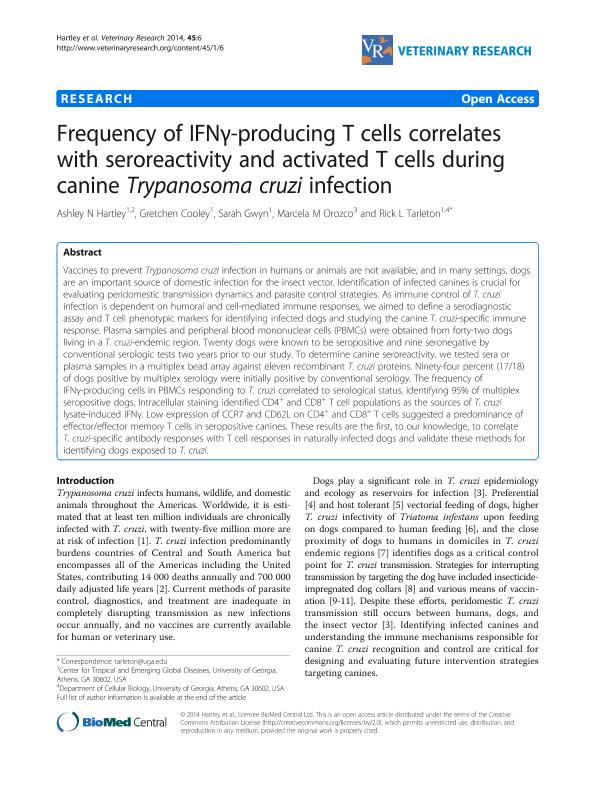Mostrar el registro sencillo del ítem
dc.contributor.author
Hartley, Ashley N.
dc.contributor.author
Cooley, Gretchen
dc.contributor.author
Gwyn, Sarah
dc.contributor.author
Orozco, Maria Marcela

dc.contributor.author
Tarleton, Rick L.
dc.date.available
2019-10-03T21:21:36Z
dc.date.issued
2014-01
dc.identifier.citation
Hartley, Ashley N.; Cooley, Gretchen; Gwyn, Sarah; Orozco, Maria Marcela; Tarleton, Rick L.; Frequency of IFNγ-producing T cells correlates with seroreactivity and activated T cells during canine Trypanosoma cruzi infection; BioMed Central; Veterinary Research; 45; 1; 1-2014; 1-10
dc.identifier.issn
0928-4249
dc.identifier.uri
http://hdl.handle.net/11336/85183
dc.description.abstract
Vaccines to prevent Trypanosoma cruzi infection in humans or animals are not available, and in many settings, dogs are an important source of domestic infection for the insect vector. Identification of infected canines is crucial for evaluating peridomestic transmission dynamics and parasite control strategies. As immune control of T. cruzi infection is dependent on humoral and cell-mediated immune responses, we aimed to define a serodiagnostic assay and T cell phenotypic markers for identifying infected dogs and studying the canine T. cruzi-specific immune response. Plasma samples and peripheral blood mononuclear cells (PBMCs) were obtained from forty-two dogs living in a T. cruzi-endemic region. Twenty dogs were known to be seropositive and nine seronegative by conventional serologic tests two years prior to our study. To determine canine seroreactivity, we tested sera or plasma samples in a multiplex bead array against eleven recombinant T. cruzi proteins. Ninety-four percent (17/18) of dogs positive by multiplex serology were initially positive by conventional serology. The frequency of IFNγ-producing cells in PBMCs responding to T. cruzi correlated to serological status, identifying 95% of multiplex seropositive dogs. Intracellular staining identified CD4§ssup§+§ esup§ and CD8§ssup§+§esup§ T cell populations as the sources of T. cruzi lysate-induced IFNγ. Low expression of CCR7 and CD62L on CD4§ssup§+§esup§ and CD8§ssup§+§esup§ T cells suggested a predominance of effector/effector memory T cells in seropositive canines. These results are the first, to our knowledge, to correlate T. cruzi-specific antibody responses with T cell responses in naturally infected dogs and validate these methods for identifying dogs exposed to T. cruzi.
dc.format
application/pdf
dc.language.iso
eng
dc.publisher
BioMed Central

dc.rights
info:eu-repo/semantics/openAccess
dc.rights.uri
https://creativecommons.org/licenses/by-nc-sa/2.5/ar/
dc.subject
TRYPANOSOMA CRUZI
dc.subject
VACCINES
dc.subject.classification
Bioquímica y Biología Molecular

dc.subject.classification
Ciencias Biológicas

dc.subject.classification
CIENCIAS NATURALES Y EXACTAS

dc.title
Frequency of IFNγ-producing T cells correlates with seroreactivity and activated T cells during canine Trypanosoma cruzi infection
dc.type
info:eu-repo/semantics/article
dc.type
info:ar-repo/semantics/artículo
dc.type
info:eu-repo/semantics/publishedVersion
dc.date.updated
2019-10-02T20:54:29Z
dc.identifier.eissn
1297-9716
dc.journal.volume
45
dc.journal.number
1
dc.journal.pagination
1-10
dc.journal.pais
Reino Unido

dc.description.fil
Fil: Hartley, Ashley N.. University of Georgia; Estados Unidos
dc.description.fil
Fil: Cooley, Gretchen. University of Georgia; Estados Unidos
dc.description.fil
Fil: Gwyn, Sarah. University of Georgia; Estados Unidos
dc.description.fil
Fil: Orozco, Maria Marcela. Consejo Nacional de Investigaciones Científicas y Técnicas. Oficina de Coordinación Administrativa Ciudad Universitaria. Instituto de Ecología, Genética y Evolución de Buenos Aires. Universidad de Buenos Aires. Facultad de Ciencias Exactas y Naturales. Instituto de Ecología, Genética y Evolución de Buenos Aires; Argentina
dc.description.fil
Fil: Tarleton, Rick L.. University of Georgia; Estados Unidos
dc.journal.title
Veterinary Research

dc.relation.alternativeid
info:eu-repo/semantics/altIdentifier/doi/http://dx.doi.org/10.1186/1297-9716-45-6
dc.relation.alternativeid
info:eu-repo/semantics/altIdentifier/url/https://veterinaryresearch.biomedcentral.com/articles/10.1186/1297-9716-45-6
Archivos asociados
